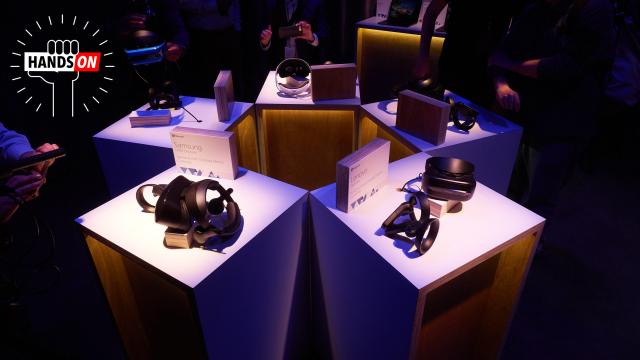VR, like that one cousin on Facebook, can be hard to love. The potential is there, and you have all these fond memories — mainly rooted in cool science fiction books you’ve read — but in reality VR is pricey, buggy, and kind of limited to one experience: Games. Yet Microsoft has been making a lot of low key noise about VR, AR and mixed reality recently, and how it can be more than a tool for fragging aliens.
All images: Alex Cranz/Gizmodo
After finally trying out the most complete Microsoft mixed reality experience we’re likely to get this year, it looks like Microsoft might have built something that actually won’t suck. This isn’t the promise of goggle-based computing that William Gibson, Neal Stephenson and even former Gizmodo EIC Annalee Newitz have espoused in their cyberpunk novels, but it’s the first mixed reality experience that feels like more than a gimmick or a tool for gamers alone.
What is mixed reality? It’s Microsoft’s term used to encompass the spectrum of digital reality. The goal, one day, is that MR will cover everything from the augmented reality experience of Hololens to the new virtual reality-based operating system launching in two weeks with the Fall Update of Windows 10.
Absent a Hololens in every home, for now mixed reality is more synonymous with Microsoft’s upcoming VR headsets. Starting in two weeks, people will be able to pick up a VR headset from partners such as Acer, Dell or Samsung. Plug one of those headsets into a recent PC, slip it on, and it will take you to Cliff House, a modern virtual space with big windows and straight lines.
It really does look like a digital version of a fancy house you might find nested beside a cliff in California. There’s greenery in the distance, blond wood floors, and white walls that rise above you. Familiar Windows apps are tacked onto the walls. You can walk around the space like you would your own home, or you can lazily teleport using the controllers Microsoft announced back at Build in May. Opening apps and then tacking them to the wall is all incredibly intuitive.
Messing around with it today after Microsoft’s big mixed reality announcement event, I could see myself blogging from Microsoft’s VR world, my Twitter feed above me, a small blog window down on my lap like a laptop, and huge space for Photoshop directly in front of me. If, for some reason, I needed to write a huge text document or some code, I could make a screen that shows the whole thing — an instant portrait monitor. Got to edit a two-hour flick? Instead of spending thousands on 40-inch monitors, I could build a custom video editing rig right into the Cliff House with nothing more than a flick of my wrist. Want to switch things up and watch a movie? I could teleport instantly to a darkened room with a 300-inch equivalent display in front of me.
Games, which include a new Halo release and the whole library of VR games available on Steam, are part of the experience, but they’re not the main event. Microsoft is hoping, instead, that Cliff House will be where people live their virtual lives.
While it was a strictly controlled demo, Microsoft appears to have worked out a lot of the kinks that were in the versions of Cliff House I’ve tried before. In particular, the company appears to have addressed how the headsets track the real world and your every movement. Previously, it was shaky — as bad if not worse than Sony’s PSVR or a mobile headset like the Samsung Gear VR. But now it is nearly as smooth and as nausea-free as the HTC Vive. Microsoft headset and controller bundles start at $US400 ($511), the Vive starts at $US500 ($638) and requires a powerful computer and complicated setup.
But Microsoft is promising something that is key to adoption versus any other competitor on the PC. It’s promising that this new VR experience will actually work on a PC with integrated graphics (absent blockbuster games, which will still have prodigious graphic requirements). That means your super thin Dell, or even the new Razer Stealth, could usher you into a virtual world. Previous VR experiences of the mixed reality calibre have required rigs that cost thousands of dollars. All mixed reality requires is a Kaby Lake or better processor.
The real star of the experience will be the new Samsung HMD Odyssey. This headset will go for $US500 ($638) with controllers and featured AMOLED displays with a higher resolution than any other headset on the market. The 1440 x 1600-per-eye displays add up to a lot more pixels than the 1080 x 1200-per-eye displays found in the similarly priced HTC Vive. I tried both the Samsung headset and a headset from Dell (1440 x 1440-per-eye) and the difference was nearly night and day. Everything felt smoother on the Samsung device, and the little pixels on the display, which are noticeable in any VR experience, seemed a little smaller and less distracting on the Samsung headset.
Virtual reality is still in its infancy, and there’s still a lot of competition, but Microsoft is better poised than just about any other company to realise the dream of ubiquitous mixed reality. With headsets priced the same as those found at Oculus and HTC, but a potentially richer and less game-focused experience, and what could be the breeziest set up of anything outside of the mobile VR space, Microsoft could be building something that’s exciting for more than just nerds like me.
